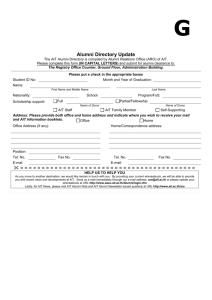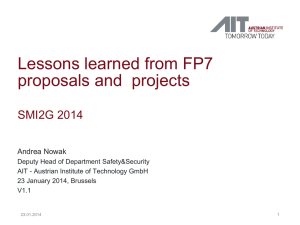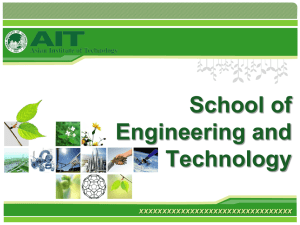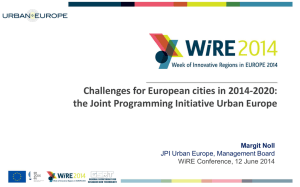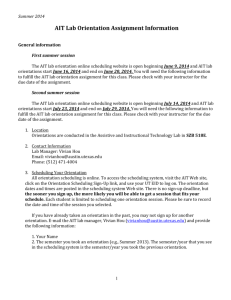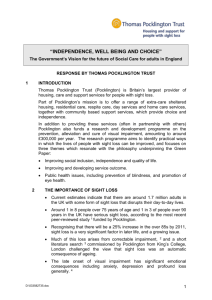Trends in assistive and inclusive technology
advertisement
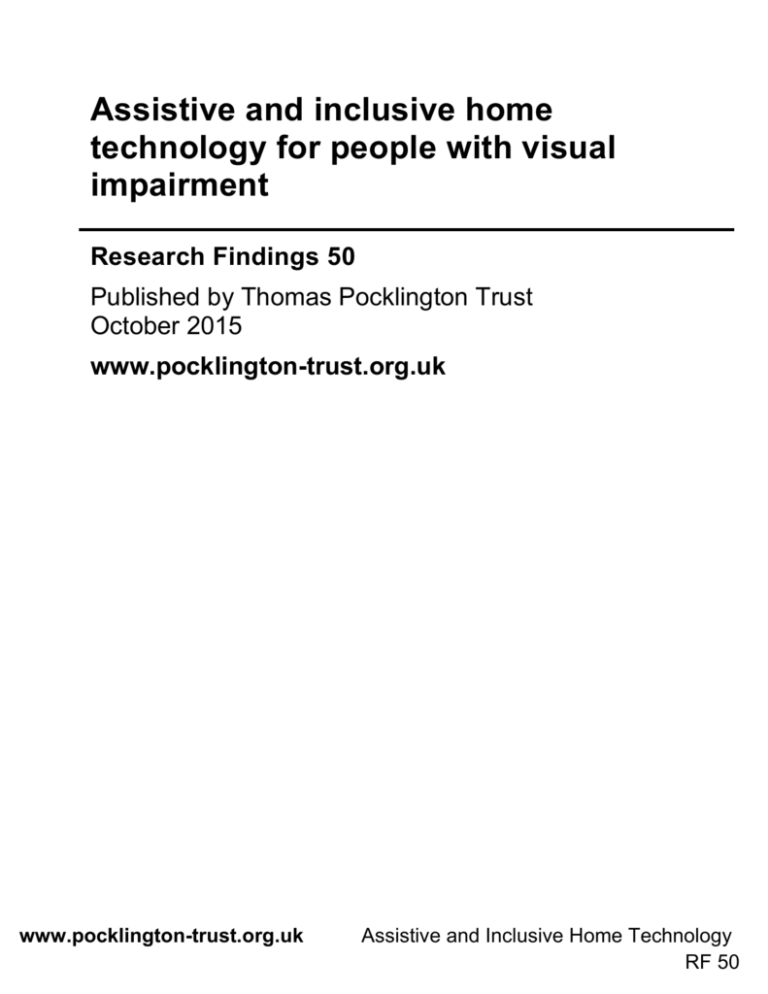
Assistive and inclusive home technology for people with visual impairment Research Findings 50 Published by Thomas Pocklington Trust October 2015 www.pocklington-trust.org.uk www.pocklington-trust.org.uk Assistive and Inclusive Home Technology RF 50 Summary findings There have been many radical, high-tech innovations in recent years, often associated with the advance of mobile integrated technology devices. Some innovations open up exciting access opportunities for visually impaired people, while others offer the functionality of traditional assistive technology (AT) at lower cost. Increasing visualisation of information, inaccessible touchscreens and miniaturisation of devices can create barriers for people with sight loss, while mainstream trends towards integrated technology devices, user-friendliness and personalisation represent opportunities for a revolution in inclusivity. The research found, on balance, an overall positive outlook for the future of AIT. This is largely because the market leaders in the technology industry are now paying serious attention to inclusive design and they are likely to set the trend for smaller players in the market. There is a gap between the availability of useful and accessible AIT and the practical use of the technology by people with sight loss. There is a need to provide continually updated and reliable information about what AIT exists, where to find it and how to compare different products and technologies. Background and context Around 1.87 million people in the UK are living with sight loss that has an impact on their day to day living. Specialist assistive technology, based on purpose-designed products, has played an important role in enabling people with visual impairment to keep their independence, develop new skills and broaden their experiences. The advance of new technologies offers great potential for development of both specialist devices and mainstream products that make life easier in the home environment and elsewhere. Research aims and scope The aims of the overview research were: To collect and organise information on the range of technologies, products and systems currently available; www.pocklington-trust.org.uk Thomas Pocklington Trust RF50 Page 2 of 11 To explore advances and trends in assistive and inclusive technology and investigate new and emerging systems and products; To present options on the scope, content and format of new guidance and information resources. The research covered: Products, devices and systems designed primarily for people with sight loss; More general assistive technology that is useful to people with sight loss; Inclusive technology and accessible features that are integral to mainstream products and devices designed for everyone. Research methods Extensive desk-based and online research was undertaken and expert informants were identified and consulted. The interviewees included academics, researchers, technology developers, frontline advisors, technology users and experts from non-profit organisations in the sight loss sector. Current and Emerging AIT Home environmental control Inclusive technology such as over-counter lighting and dimmer switches can be very useful for visually impaired people. Other examples include the Philips Hue Personal Lighting System, which enables personal control of lighting through a smartphone app, and the British Gas Hive app, which similarly facilitates control of heating and hot water. The integration of such systems with systems that control door access, window blinds etc. shows that the smart home will soon become a reality. Household chores and tasks Streamlined design and digital visual displays often make modern appliances less accessible than their older versions. On the positive side, manufacturers such as Whirlpool are significantly improving accessibility across a range of appliances, such as a new washerdryer featuring auditory feedback to improve control. Smartphone www.pocklington-trust.org.uk Thomas Pocklington Trust RF50 Page 3 of 11 controlled kettles and talking microwaves are also available, as are gadgets such as one-touch tin openers, talking utensils, liquid level indicators, needle threaders, sock locks and audible spirit levels. Timekeeping There is a wide range of clocks and watches that assist timekeeping by speaking or vibrating. The Bradley Timepiece is a tactile watch and this popular product is a good example of how AIT can be desirable to consumers when it is purposefully designed as an attractive and aesthetically pleasing product. Recognising, identifying and locating Braille stickers, tactile markers, squeeze-on marking gel and Penfriend audio-label technology can facilitate useful identification systems. Specialist money identification and colour recognition equipment is increasingly being replaced with mobile apps, which are often available at no cost. Other software can read barcodes (DigitEyes) identify objects (TapTapSee) or crowd source remote volunteers to assist with recognition (Be My Eyes). Smart glasses being developed at Oxford University use image enhancement software to enable easier human recognition and identification. Reading and writing Extra-large stationery, signature guides and writing frames are examples of basic AIT to assist with reading and writing. Swelling tactile paper and scented pens are also available. Specialist electronic, handheld magnifiers and large-display CCTV machines are increasingly being replaced by freely available mobile and computer software. The functionality of specialist reading machines can be replicated through apps such as the iPhone’s KNFB Reader. Braille technology, such as note-takers, refreshable displays and writing machines, is also available. Accessing computers and online resources Extra-large monitors, special keyboards and tactile stickers can help to enable computer access. Screen magnification tools (such as ZoomText) can enlarge images and improve contrast, while screen readers (such as JAWS) speak out the contents of the screen. Apple’s Mac computers come with many accessibility features as standard, with software for screen-reading, magnification, contrasting, www.pocklington-trust.org.uk Thomas Pocklington Trust RF50 Page 4 of 11 text-to-speech, speech-to-text, etc. Comprehensive bundles of AIT software are also available to be installed on other computers. Entertainment and leisure E-books have enabled access to vast amounts of previously inaccessible text and the latest kindle e-readers have accessibility features built in. The ‘Sonata’ device can access internet radio and podcasts. Voice-control can be used to access new TVs and .audiodescribed (AD) programmes are increasingly available. Mainstream music cloud services give access to a huge amount of audio content online and provide an example of how dematerialisation of products can make things easier for all. Accessible, eyes-free computer games have also been developed. Health, fitness and wellbeing Talking pedometers and talking timers can help with fitness, audiothermometers and talking blood sugar level monitors can help to maintain health and accessible pill-organisers and ergonomic eyedrop dispensers can assist in managing medication. Telecare and TeleHealth systems can be useful for visually impaired people who have other disabilities or health conditions. Communication and interfacing with technology Doro easy-see phones and BT Big Button phones are accessible landline devices. The Alto2 talking phone is a specialist, accessible mobile device with tactile controls. For many people, mobiles are moving towards being the single access gateway to a huge range of technologies, enabling lighting control, household appliance operation, object identification, reading, writing, web searching, shopping, banking, etc. to be coordinated using one device. Apple led the way by building accessibility into its integrated devices as standard and many other developers have since followed suit. Trends in assistive and inclusive technology Assistive technology is increasingly recognised as an important subject for research and development. As the world becomes more techno-centric, assistive technology is blurring into other areas, such as architecture, design, lighting and technologies for assisted living, health and rehabilitation. Crucially, it seems that AT may be blurring into the www.pocklington-trust.org.uk Thomas Pocklington Trust RF50 Page 5 of 11 technological mainstream, with a stress on inclusivity becoming noticeable in certain key areas. Although many low-tech, specialist AT products are popular and unlikely to need radical improvement, at the higher-tech end there are numerous cases of specialist AT equipment being effectively made obsolete by inclusive mainstream technology (often smartphone apps). Highly effective text reader or electronic magnification apps can be obtained for free (after the initial outlay for the mobile device) and can replace expensive specialist equipment. Key technology developers are opting for inclusivity because it closely aligns with significant business and technology trends. Notable among these are trends towards user-friendliness and personalisation, driven by mainstream consumers wanting products that are easy to use and customisable. Many improvements occur largely by accident (e.g. Amazon Audio was primarily developed so that mainstream users could choose to read or to be read to). Technology developers are also realising that they can work with disabled people (‘specialist’ users) to test whether their products are generally user friendly. In such organisations, accessibility is moving from the fringe (Corporate Social Responsibility) to the core of the business (Product Development). In contrast to these positive developments, there are trends that point towards increased exclusion of visually impaired people. Visualised information, miniaturisation and touchscreens can make household appliances less inclusive, with new designs often lacking tactile feedback. Gadgets are getting smaller and more complicated and information is increasingly presented in visual form as more products are fitted with graphic displays. The debate about how the move to touchscreen devices affects inclusivity is complex and relates to the trend towards integrated technology devices, which hold so much promise for AIT. Wider technology trends Information visualisation The trend towards information visualisation is not generally positive for people with sight loss. However, many efforts are being made to translate visual information into other forms. The Microsoft Soundscape Headband enables a sound-based understanding of the www.pocklington-trust.org.uk Thomas Pocklington Trust RF50 Page 6 of 11 spatial environment, while haptic technology transforms images into tactile feedback. The visualisation trend could be one aspect of a multi-sensory ‘realisation’ trend, leading towards an immersive, sensory-rich (and more accessible) virtual environment. Miniaturisation and streamlining Small, fiddly devices can be difficult to operate for visually impaired people but the problems could potentially be mitigated through the use of accessible gateway devices or voice control. One advantage is that miniaturisation can enable wearable technology and improve the aesthetics of AIT. Touchscreens A touchscreen that is equipped with a screen-reader can improve accessibility. As touchscreens become more prevalent on appliances and door systems, accessibility should be considered as standard. An example of developing eyes-free touchscreen technology involves a dialling system with the numbers positioned systematically relative to where the finger first touches. Integrated technology devices The reality of modern integrated technology devices (mobiles and tablets) has already been transformative for many users of AIT. The trend is towards deeper and broader integration of technologies. It is plausible that mobile devices could become door keys, bank cards, ID cards, etc., as well as gateways to many other functions. 3D Printing 3D Printing enables greater personalisation of products and could change the economics of production in favour of decentralised, localised production. This could enable specially-adapted assistive equipment to be ‘printed’ at a low cost. People with disabilities are already using online innovation forges to develop personalised AIT. Open innovation and crowdsourcing Open sourcing software development enables the core code to be modified and adapted by others, making it easier to build in accessibility features. Crowd sourced innovation can facilitate usercentred design and enable co-creation between producers and www.pocklington-trust.org.uk Thomas Pocklington Trust RF50 Page 7 of 11 consumers. Other examples of positive accessibility impacts include: crowd sourced development of audio books; online volunteer remote assistance via mobile; and open source development of AIT software and hardware. Voice recognition and the conversational internet Since Siri first cracked the problem of reliable voice recognition for iPhone users, Apple’s rivals have developed competitive alternatives such as Android’s Voice Assistant. As this technology advances there is scope for a huge range of AIT to be voice controlled and the tantalising prospect of the fully conversational internet. Internet of Things A proliferation of computer chips inside a wide variety of machines and objects has given rise to the concept of the internet of things. This is now being used to facilitate beacon technology for outside navigation and will also be used within the home as appliances become increasingly smart (e.g. fridges that can assess food safety). Computer vision Computers are getting dramatically better at recognising writing, objects, faces and expressions. In simple conditions most of these problems are effectively solved, although the technology can falter in complex and chaotic real world environments. Advancing computer vision technology is enabling wearable Glass technology to move forward on a variety of fronts. Wearable technology Google’s 2014 ‘Give Vision’ project aimed to combine text, object, face, expression and environment recognition technology in an ambitious piece of Glass AIT that could narrate the visual world to a visually impaired user. Smart watches and technologies such as finger-worn text readers may also have a positive impact. Haptic technology A Disney-backed project has developed prototype technology that enables images on a touchscreen to be felt, by creating a tactile illusion for the finger. There are also attempts to develop effective artificial skins that could sheath touchscreens to enable greater www.pocklington-trust.org.uk Thomas Pocklington Trust RF50 Page 8 of 11 tactility. Bristol-based company Ultra-haptics has developed technology that can create dramatic, tactile illusions above the surface of its special device. Aesthetics and Design Personal technology is cool and stylish in the mainstream. Slick and aesthetically-pleasing devices such as the iPhone and iPad are highly desirable status symbols and it is now normal for people to walk around with multiple gadgets. AIT should be designed to be as appealing as possible, in order to reduce stigma and promote its use. Using AIT in Practice Despite the impressive progress in technical capability, the potential benefits of the already-available technology are far from being realised. Reasons for this include: Visually impaired people may not know what products exist; They may have difficulties acquiring or learning to use AIT; They may be sceptical about technology in general People decide what technology to use based on what works for them in their specific context and whether they believe that the technology is reliable. Financial cost and the stigma traditionally attached to AT are also significant factors. Deciding whether to use AIT (or what AIT to use) is a matter of personal preference. Technophiles will jump at the chance to try out new technologies, while many people are instinctively technophobic. There is often a ‘hump’ when it comes to learning to use a particular piece of technology (smartphones, for example). Training and education (both formal and informal) can play a significant role in encouraging use of AIT. People need to habituate their use of AIT in order to maximise its benefits, so it is important to think about how technology fits into someone’s lifestyle and habits. There is recognition across the sight loss sector that provision of information on AIT needs to be improved in order for the technologies to be known and understood and the benefits to be realised. There should be more opportunity for people to search from a task-oriented perspective and www.pocklington-trust.org.uk Thomas Pocklington Trust RF50 Page 9 of 11 start with the real life issue e.g. ‘what options are available to help me with reading?’ rather than ‘what types of magnifier are available?’ Bringing together information and guidance on mainstream and specialist products would also be useful, as would systems that allow people to obtain details, compare products and make a more informed choice. Summary conclusion In conclusion, this review has shown that many exciting technological solutions are there to be taken up and that leading technology developers are promoting inclusive design as a positive benefit for everyone. People with sight loss need better advice and information and could play a significant part in highlighting barriers to obtaining and using technology and helping to shape technological innovation to assist daily living. How to obtain further information This paper summarises the full review report by Jay Stow, which is available on the Pocklington website at: www.pocklington-trust.org.uk Please contact Thomas Pocklington Trust at: research@pocklingtontrust.org.uk or Tel: 020 8090 9268 to obtain a copy of the full report or this paper in an accessible format. www.pocklington-trust.org.uk Thomas Pocklington Trust RF50 Page 10 of 11 Thomas Pocklington Trust Pier House, 90 Strand on the Green, London W4 3NN Tel: 020 8995 0880 Email: research@pocklington-trust.org.uk Web: www.pocklington-trust.org.uk Published by Thomas Pocklington Trust Registered Charity No. 1113729 Company Registered No. 5359336 Research Findings 50 www.pocklington-trust.org.uk Thomas Pocklington Trust RF50 Page 11 of 11
